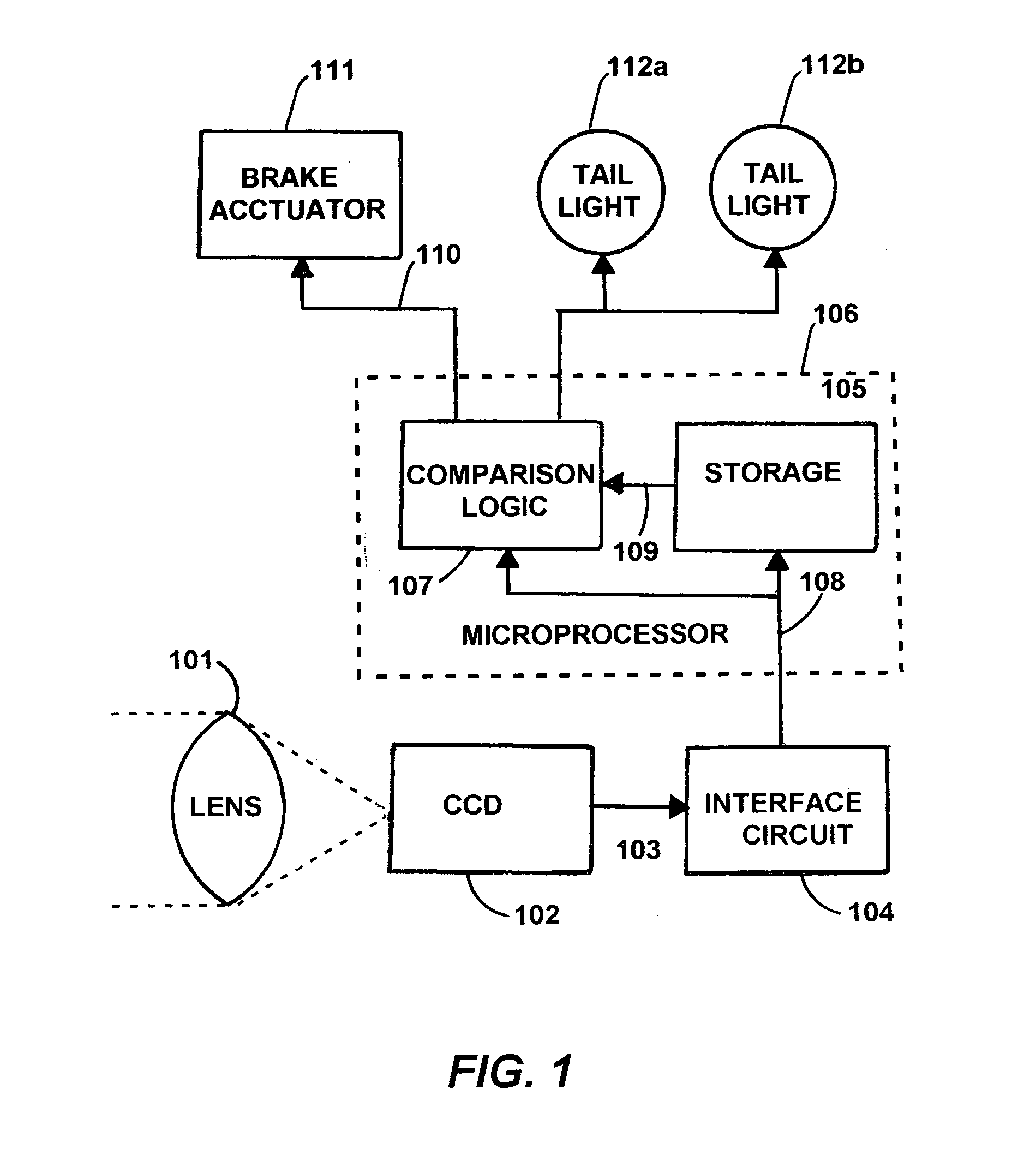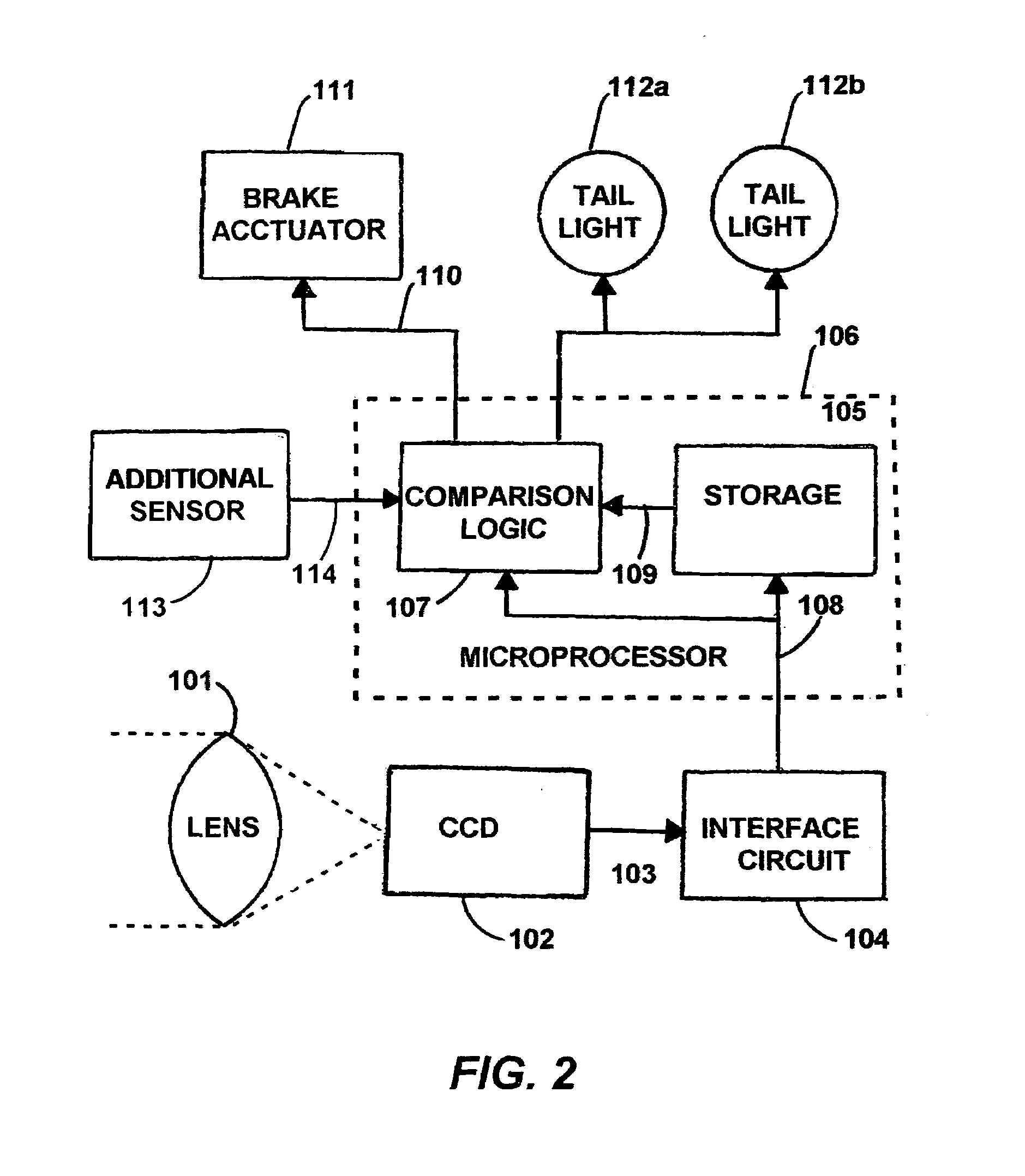Activating a vehicle's own brake lights and/or brakes when brake lights are sensed in front of the vehicle, including responsively to the proximity of, and/or rate of closure with, a forward vehicle
a technology of brake lights and brakes, applied in the field of vehicle safety, can solve the problems of a large number of deaths, more than three million injuries, and a large amount of financial losses, and achieve the effects of reducing the number of deaths, increasing the cost of operation, and increasing the number of injuries
- Summary
- Abstract
- Description
- Claims
- Application Information
AI Technical Summary
Benefits of technology
Problems solved by technology
Method used
Image
Examples
fourth embodiment
8. a Vehicle Brake Light Sensing and Control System
[0077]A fourth preferred embodiment may be block diagrammed (not shown) equivalently to any of the above preferred embodiments one through three, excepting only that the color CCD sensor (standard red-green-blue device) 102 shown in FIGS. 1 and 2 is replaced with a sensor wherein the sensed wavelengths (colors) are modified so that at least one of the wavelengths is well into the infrared. Such an infrared sensor is capable of sensing hot tailpipes, even during bad visibility conditions as are due to, most commonly, fog. Moreover, the logic of detection is modified so as to consider the intensity of warm or hot objects ahead, and the rate of change of such intensity. This information, possibly coupled with taillight data and / or radar proximity data, is used to form a more accurate estimate of what vehicles are ahead, and what the closure rate to these vehicles might be.
fifth embodiment
9. a Vehicle Brake Light Sensing and Control System
[0078]A fifth preferred embodiment of the present invention is similar to any of the above preferred embodiments, except that instead of using just a single CCD optical sensor, two such sensors are used in a stereoscopic mode. Differences between what each of the two sensors detects are considered in developing such 3-dimensional information as provides both (i) estimated distance, and (ii) rates of change in estimated distance, to objects ahead of the subject vehicle. Because the separation of two separate sensors provides a wider baseline over which trigonometric calculations of distance may be made, the two separate sensor system delivers enhanced ranging accuracy. Such range information may be used singly, or in concert with any of the other types of information developed for any of the preferred embodiments.
sixth embodiment
10. a Vehicle Brake Light Sensing and Control System
[0079]A sixth preferred embodiment of the present invention is similar to any of the above preferred embodiments, except that instead of, or in addition to, the brake activation and / or taillight activation outputs, a driver alert indication or warning is activated, this serving as either a visual and / or an audio alarm or indication. For example, at a first threshold of the aforesaid “points” as do indicate a likelihood of collision, an alarm warning, which is preferably audible, is sounded. This audio alarm might be of a constant intensity or pitch, or of an intensity or pitch varying with the estimated time to impact. At a second threshold, the vehicle's taillights are activated. At a third threshold, the vehicle's brakes are activated. These various thresholds may be identical or different in magnitude.
11. A Seventh, Hybrid, Embodiment of a Digital Vehicle Brake Light Sensing and Control System with (i) Analog Sensing and (ii) Di...
PUM
 Login to View More
Login to View More Abstract
Description
Claims
Application Information
 Login to View More
Login to View More - R&D
- Intellectual Property
- Life Sciences
- Materials
- Tech Scout
- Unparalleled Data Quality
- Higher Quality Content
- 60% Fewer Hallucinations
Browse by: Latest US Patents, China's latest patents, Technical Efficacy Thesaurus, Application Domain, Technology Topic, Popular Technical Reports.
© 2025 PatSnap. All rights reserved.Legal|Privacy policy|Modern Slavery Act Transparency Statement|Sitemap|About US| Contact US: help@patsnap.com



